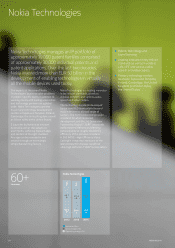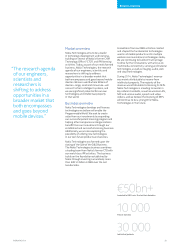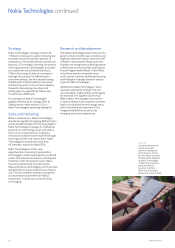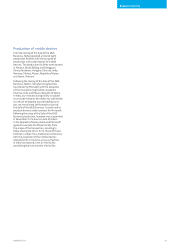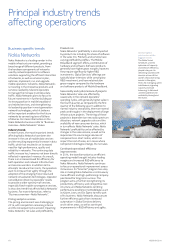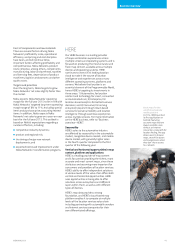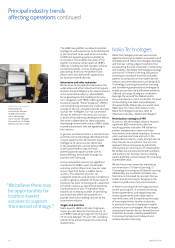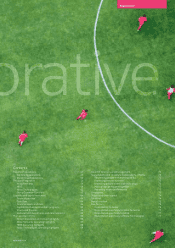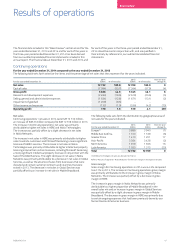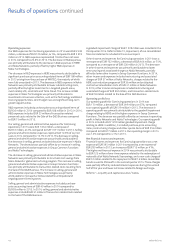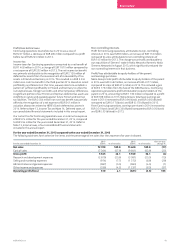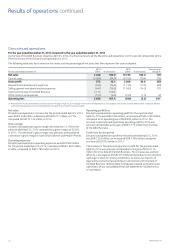Nokia 2014 Annual Report Download - page 45
Download and view the complete annual report
Please find page 45 of the 2014 Nokia annual report below. You can navigate through the pages in the report by either clicking on the pages listed below, or by using the keyword search tool below to find specific information within the annual report.
Business overview
43NOKIA IN 2014
In Technology Licensing the opportunities
are more long-term in our view, but we will
look at opportunities to license technologies
developed by Nokia Technologies and
delivered to partners in consumer electronics
as solutions or technology packages that can
be integrated into their products and services
to help enable the Programmable World.
In Brand Licensing, we will continue to look at
further opportunities to bring the Nokia brand
into consumer devices, by licensing our brand
and other intellectual property, as well as,
for example, industrial design.
To grow each of the aforementioned business
programs it is necessary to invest in
commercial capabilities to support them.
General trends in IPR licensing
In general, there has been increased focus
on IPR protection and licensing, and this
trend is expected to continue. As such,
new agreements are generally a product of
lengthy negotiations and potential litigation
or arbitration, and therefore the timing
and outcome may be dicult to forecast.
Due to the structure of the patent license
agreements, the payments may be very
infrequent, at times retrospective in part, and
the lengths of license agreements can vary.
Additionally, there are clear regional
dierences in the ease of protecting and
licensing patented innovations. We have
seen some licensees actively avoiding license
payments, and some licensors using
aggressive methods to collect them, both
behaviors attracting regulatory attention.
We expect the discussion on the regulation
of licensing to continue on both a global and
regional level. Some of those regulatory
developments may be adverse to the
interests of technology developers and
patentowners, including Nokia.
Research, development and patent
portfolio development
As the creation of new technology assets
and patented innovations is heavily focused
on R&D activities with long lead-time to
incremental revenues, we may from time to
time see investment opportunities that have
strategic importance. This generally aects
the operating expenses before sales reect
a return on those investments.
Targets and priorities
Nokia expects Nokia Technologies’ net sales
to grow on a year-on-year basis for the full
year 2015, excluding potential amounts
related to the expected resolution of the
arbitration with Samsung. Also, Nokia expects
Nokia Technologies’ operating expenses,
excluding special items and purchase
priceaccounting related items, to increase
meaningfully on a year-on-year basis for the
full year 2015. More specically, Nokia expects
Nokia Technologies’ quarterly operating
expenses, excluding special items and
purchase price accounting related items,
in2015 to be approximately in-line with
thefourth quarter 2014 level. This is related
to higher investments in licensing activities,
licensable technologies, and business
enablers including go-to-market capabilities,
which target new and signicant long-term
growth opportunities.
Trends aecting our businesses
Exchange rates
Nokia is a company with global operations and
net sales derived from various countries and
invoiced in various currencies. Therefore,
our business and results from operations
are exposed to changes in exchange rates
between the euro, our reporting currency,
and other currencies, such as the US dollar,
Japanese yen and the Chinese yuan. The
magnitude of foreign exchange exposures
changes over time as a function of our net
sales and costs in dierent markets, as well as
the prevalent currencies used for transactions
in those markets. Refer also to “General Facts
on Nokia—Selected nancial data—Exchange
rate data” below.
To mitigate the impact of changes in
exchange rates on our results, we hedge
material net foreign exchange exposures
(net sales less costs in a currency). We hedge
forecasted net cash ows typically with up to
12-month hedging horizon. For the majority
of these hedges, hedge accounting is applied
to reduce income statement volatility.
In 2014, approximately 30% of Continuing
operations net sales and approximately 35%
of Nokia’s continuing operations costs were
denominated in euro. In 2014, approximately
30% of Nokia’s continuing operations net
sales were denominated in US dollar and
approximately 10% each were denominated
in Japanese yen, and in Chinese yuan.
During 2014, the US dollar appreciated
against the euro and this had a positive
impact on our net sales expressed in euros.
However, the stronger US dollar also
contributed to higher cost of sales and
operating expenses, as approximately 30% of
our total cost base was in US dollars. In total,
before hedging, the appreciation of the US
dollar had a small positive eect on our
operating prot in 2014.
During 2014, the Japanese yen depreciated
against the euro and this had a negative
impact on our net sales expressed in euros.
However, the weaker Japanese yen also
contributed to lower cost of sales and
operating expenses, as approximately 5%
ofNokia’s continuing operations total costs
were denominated in Japanese yen. In total,
before hedging, the depreciation of the
Japanese yen had a small negative eect
onour operating prot in 2014.
During 2014, the Chinese yuan appreciated
against the euro and this had a positive
impact on our net sales expressed in euros.
However, the stronger Chinese yuan also
contributed to higher cost of sales and
operating expenses, as approximately 10%
ofNokia’s continuing operations total costs
were denominated in Chinese yuan. In total,
before hedging, the appreciation of the
Chinese yuan had a small negative eect
onour operating prot in 2014.
Signicant changes in exchange rates may
also impact our competitive position and
related price pressures through their impact
on our competitors.
For a discussion on the instruments used
by Nokia in connection with our hedging
activities, refer to Note 35, Risk management,
of our consolidated nancial statements
included in this annual report. Refer also
to “Board review—Risk Factors—Risks relating
to Nokia”.



